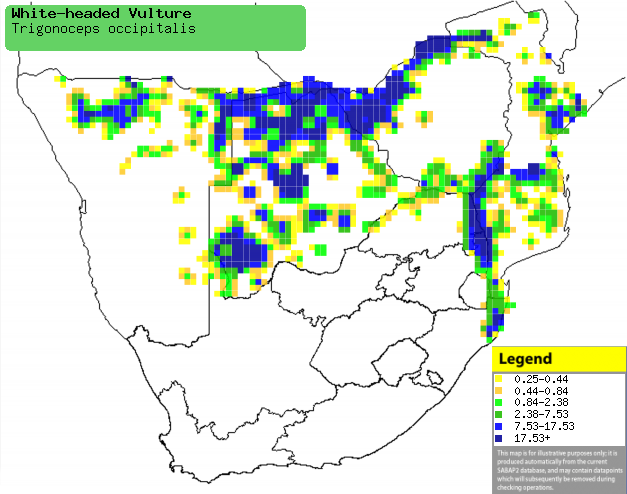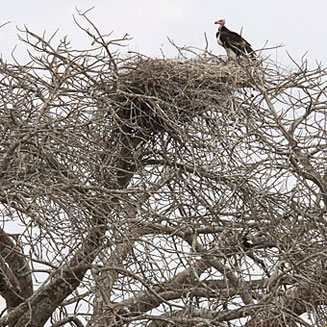|
Aegypius occipitalis
(White-headed vulture)
[= Trigonoceps occipitalis]
WitkopaasvoŽl [Afrikaans]; Ekuvi (generic term for
vulture) [Kwangali]; Gora (generic name for vulture) [Shona]; Lingce
(generic term for vulture) [Swazi]; Koti (generic term for vulture)
[Tsonga]; Witkopgier [Dutch]; Vautour ŗ tÍte blanche [French];
Wollkopfgeier [German]; Abutre-de-cabeÁa-branca [Portuguese]
Life
> Eukaryotes >
Opisthokonta
> Metazoa (animals) >
Bilateria >
Deuterostomia > Chordata >
Craniata > Vertebrata (vertebrates) > Gnathostomata (jawed
vertebrates) > Teleostomi (teleost fish) > Osteichthyes (bony fish) > Class:
Sarcopterygii (lobe-finned
fish) > Stegocephalia (terrestrial
vertebrates) > Tetrapoda
(four-legged vertebrates) > Reptiliomorpha > Amniota >
Reptilia (reptiles) >
Romeriida > Diapsida > Archosauromorpha > Archosauria >
Dinosauria
(dinosaurs) > Saurischia > Theropoda (bipedal predatory dinosaurs) >
Coelurosauria > Maniraptora > Aves
(birds) > Order: Falconiformes
> Family: Accipitridae
> Genus: Aegypius
Distribution and habitat
Occurs in isolated patches around the Red Sea and across
sub-Saharan Africa. In southern Africa it is uncommon in north-west-Zimbabwe, Botswana,
northern Namibia, Mozambique and eastern South Africa, generally preferring
semi-arid woodland, such as Mopane (Colosphermum mopane), miombo (Brachystegia)
and mixed woodland.
|
 |
|
Distribution of White-headed vulture in southern
Africa, based on statistical smoothing of the records from first SA Bird
Atlas Project (©
Animal Demography unit, University of
Cape Town; smoothing by Birgit Erni and Francesca Little). Colours range
from dark blue (most common) through to yellow (least common).
See here for the latest distribution
from the SABAP2. |
Predators and parasites
Nestlings have been recorded as prey of Aquila verreauxii (Verreauxs'
eagle).
Movements and migrations
Resident but probably nomadic in the
non-breeding season.
Food
It is an adaptable carnivore, not only feeding on carrion
but also catching its own prey and stealing the food of other birds (kleptoparasitism).
When scavenging, it is often the first at the carcass, dominant over most other
vultures excluding the larger Lappet-faced
vulture, but generally staying away from the frenzy at the carcass, instead
stealing from other scavengers and feeding on the food they drop. It hunts
a variety of prey, including the following animals:
- Mammals
- Birds
- Reptiles
- Amphibians
- Pyxicephalus adspersus (Giant bullfrog)
- Other
Breeding
- Monogamous, territorial solitary nester; the male collecting sticks and
hands them to the female, who incorporates them into the large nest
platform (see image below), which is lined with dry grass. It is typically
placed in a large tree, especially a Baobab (Adansonia digitata) or
Acacia, such as Knob-thorn (A. nigrescens), Umbrella thorn (A.
tortilis) or Monkey acacia (A. galpinii), but also in a
Purple-pod cluster-leaf (Terminalia prunioides).
 |
|
|
White-headed vulture at its nest, Central Kruger
Park, South Africa. [photo
Warwick Tarboton
©] |
|
- Egg-laying season is from May-October, peaking from June-July.
- It lays a single egg, which is incubated by both parents for about 55-56
days.
- The chick is brooded constantly by both adults for the first 50-60 of
days of it's life, after which the adults only visit the nest to give the
chick food; it eventually leaves the nest at about 115 days old.
Threats
Not threatened globally, but Vulnerable in South
Africa, Swaziland and Lesotho, as its population in these countries is estimated to be just
80-120 breeding pairs. Its global population is approximately 7000-12 500 individuals,
and its southern Africa population is thought to be
around 500 breeding pairs.
References
-
Hockey PAR, Dean WRJ and Ryan PG 2005. Roberts
- Birds of southern Africa, VIIth ed. The Trustees of the John Voelcker
Bird Book Fund, Cape Town.
|
